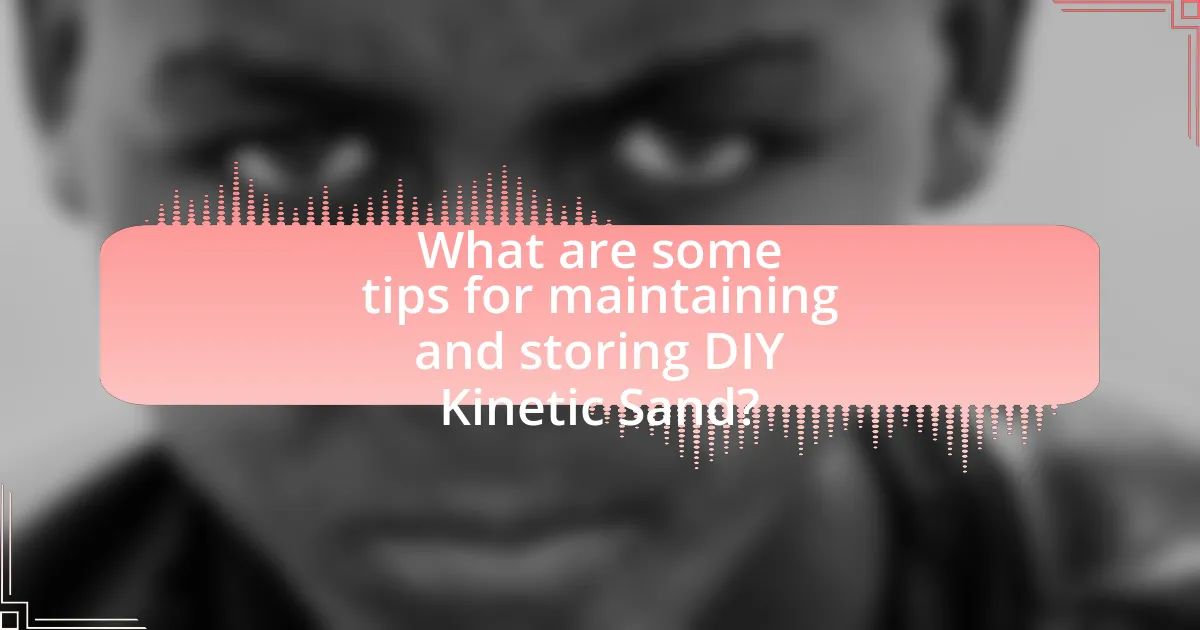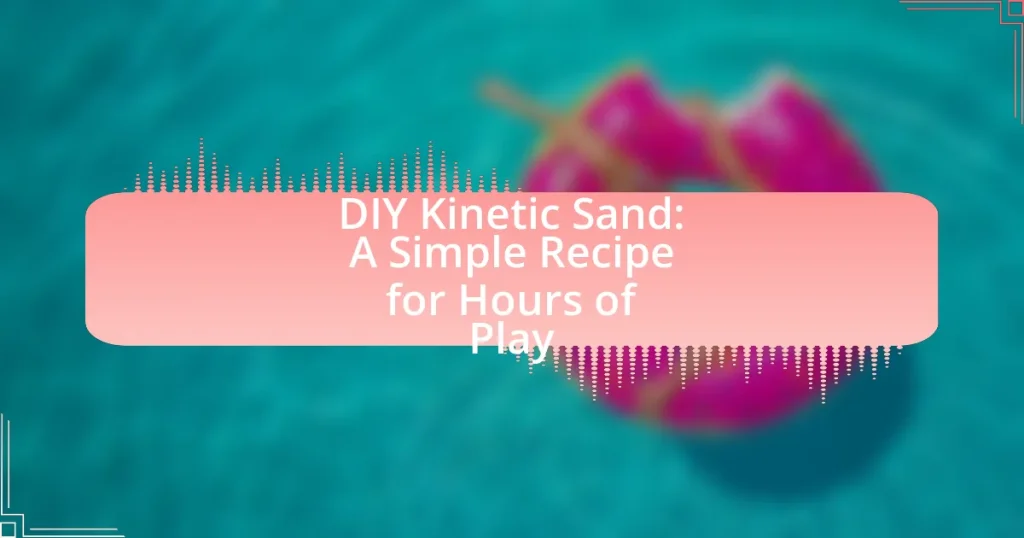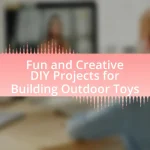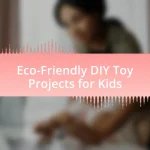DIY Kinetic Sand is a homemade version of the popular play material that combines sand with a binding agent, such as cornstarch, to create a moldable and tactile substance. This article explores the unique properties of DIY Kinetic Sand, highlighting its differences from regular sand, the materials needed for its creation, and the benefits it offers for sensory play and fine motor skill development. Additionally, it provides step-by-step instructions for making DIY Kinetic Sand, tips for maintaining its texture, and suggestions for safe play practices. The article also discusses the educational and creative activities that can be enhanced through the use of this engaging material.

What is DIY Kinetic Sand?
DIY Kinetic Sand is a homemade version of the popular play material that mimics the properties of wet sand, allowing it to be easily molded and shaped. This type of sand is typically made by combining regular sand with a binding agent, such as cornstarch or flour, and water, creating a tactile and malleable substance that provides sensory play experiences. The DIY approach allows for customization in texture and color, making it accessible and affordable for various creative activities.
How is DIY Kinetic Sand different from regular sand?
DIY Kinetic Sand is different from regular sand because it is a mixture of sand and a binding agent, typically a polymer, which gives it a unique, moldable texture that allows it to stick to itself without making a mess. Regular sand, on the other hand, consists of loose granules that do not adhere to one another, resulting in a dry and crumbly texture. The addition of the binding agent in DIY Kinetic Sand enables it to flow and be shaped easily, providing a sensory experience that is not achievable with regular sand.
What unique properties does DIY Kinetic Sand possess?
DIY Kinetic Sand possesses unique properties such as moldability, non-toxicity, and a sensory experience that mimics wet sand while remaining dry to the touch. This sand can easily hold shapes and is reusable, allowing for endless creative play without the mess associated with traditional sand. Its composition typically includes a mixture of fine sand and a polymer, which gives it the ability to stick to itself rather than to surfaces, making it easy to clean up. These properties make DIY Kinetic Sand an engaging and safe option for children, promoting fine motor skills and imaginative play.
Why is DIY Kinetic Sand popular among children and adults?
DIY Kinetic Sand is popular among children and adults because it provides a sensory experience that is both engaging and therapeutic. The unique texture of Kinetic Sand allows for easy manipulation, promoting creativity and fine motor skills in children while offering stress relief and relaxation for adults. Studies have shown that tactile activities can enhance cognitive development in children and reduce anxiety in adults, making DIY Kinetic Sand an appealing option for a wide age range.
What materials are needed to make DIY Kinetic Sand?
To make DIY Kinetic Sand, you need sand, cornstarch, and water. The sand provides the primary texture, while cornstarch acts as a binding agent, giving the sand its unique moldable properties. Water is added to achieve the desired consistency, allowing the mixture to hold its shape when molded.
What types of sand are best for creating DIY Kinetic Sand?
The best types of sand for creating DIY Kinetic Sand are fine, clean sand, such as play sand or beach sand. Fine sand has small, uniform particles that allow for better cohesion when mixed with a binding agent, typically cornstarch or a similar substance. Play sand is specifically designed for children’s use, ensuring it is free from harmful materials and is safe for play. Beach sand, when washed and cleaned, can also work effectively due to its fine texture. These types of sand provide the ideal consistency and texture for creating the desired moldable and stretchable properties of Kinetic Sand.
How do different additives affect the texture of DIY Kinetic Sand?
Different additives significantly influence the texture of DIY Kinetic Sand by altering its cohesiveness, pliability, and overall feel. For instance, adding cornstarch can enhance the sand’s smoothness and make it less sticky, resulting in a softer texture that is easier to mold. Conversely, incorporating more water can create a wetter, stickier consistency, which may lead to a denser and more compact texture. Additionally, using food coloring or glitter as additives can affect the visual appeal without changing the fundamental texture, while oils can introduce a slicker feel, making the sand more malleable. These effects are supported by the principles of material science, where the interaction of different components alters the physical properties of mixtures.
What are the steps to create DIY Kinetic Sand?
To create DIY Kinetic Sand, combine 1 cup of sand, 1/2 cup of cornstarch, and 1/2 cup of water in a mixing bowl. Stir the mixture until it reaches a moldable consistency. The sand provides texture, while cornstarch adds a smooth feel, and water helps bind the ingredients together. This combination results in a substance that mimics the properties of commercial kinetic sand, allowing for easy molding and shaping.
How do you measure the ingredients for DIY Kinetic Sand?
To measure the ingredients for DIY Kinetic Sand, combine 1 cup of sand with 1/2 cup of cornstarch and 1/4 cup of water. This ratio ensures the right consistency for the kinetic sand, allowing it to hold its shape while remaining moldable. The use of sand provides the primary texture, cornstarch acts as a binding agent, and water adds moisture, creating the desired tactile experience.
What mixing techniques ensure the best consistency for DIY Kinetic Sand?
To achieve the best consistency for DIY Kinetic Sand, thoroughly mix the sand and cornstarch in a 5:1 ratio, ensuring even distribution. This technique allows the cornstarch to coat the sand particles, enhancing the texture and pliability. Additionally, gradually incorporate water while mixing to reach the desired moisture level, which should be just enough to bind the ingredients without making the mixture overly wet. This method is supported by the fact that the right balance of dry and wet ingredients creates a moldable yet non-sticky consistency, essential for effective play.

What are the benefits of playing with DIY Kinetic Sand?
Playing with DIY Kinetic Sand offers numerous benefits, including enhancing sensory development, promoting creativity, and improving fine motor skills. Sensory development is stimulated as the unique texture of kinetic sand provides tactile feedback, which is crucial for young children. Additionally, the malleability of the sand encourages imaginative play, allowing children to create various shapes and structures, thereby fostering creativity. Furthermore, manipulating the sand helps strengthen fine motor skills, as children engage in activities that require hand-eye coordination and dexterity. These benefits are supported by research indicating that sensory play is essential for cognitive and physical development in early childhood.
How does DIY Kinetic Sand enhance sensory play?
DIY Kinetic Sand enhances sensory play by providing a unique tactile experience that stimulates the senses. The combination of sand and a binding agent creates a moldable substance that feels soft and pliable, allowing children to explore textures and develop fine motor skills. Research indicates that sensory play, such as manipulating Kinetic Sand, can improve cognitive development and emotional regulation in children by engaging their senses and encouraging creativity.
What sensory experiences does DIY Kinetic Sand provide?
DIY Kinetic Sand provides tactile, visual, and auditory sensory experiences. The texture of the sand is soft and moldable, allowing for a satisfying tactile interaction as users can easily shape and manipulate it. Visually, the sand’s vibrant colors and flowing consistency create an engaging sight, enhancing the play experience. Additionally, when squeezed or moved, DIY Kinetic Sand produces a subtle sound, adding an auditory element that contributes to the overall sensory engagement. These combined experiences stimulate sensory development, particularly in children, by encouraging exploration and creativity.
How can DIY Kinetic Sand aid in fine motor skill development?
DIY Kinetic Sand aids in fine motor skill development by providing a tactile medium that encourages manipulation and control of hand movements. Engaging with Kinetic Sand requires children to pinch, roll, and shape the material, which strengthens the small muscles in their hands and fingers. Research indicates that activities involving fine motor skills, such as playing with sand, can enhance dexterity and coordination, essential for tasks like writing and buttoning clothes. The unique texture of Kinetic Sand also promotes sensory exploration, further supporting cognitive and physical development.
What creative activities can be done with DIY Kinetic Sand?
DIY Kinetic Sand can be used for various creative activities such as molding shapes, building structures, and creating intricate designs. These activities enhance fine motor skills and encourage imaginative play. For instance, children can use cookie cutters to create different shapes or sculpt figures, which promotes creativity and spatial awareness. Additionally, DIY Kinetic Sand can be combined with tools like rolling pins and molds to further expand the range of creative possibilities. Studies show that sensory play, such as working with Kinetic Sand, supports cognitive development and can improve focus and concentration in children.
How can DIY Kinetic Sand be used for educational purposes?
DIY Kinetic Sand can be used for educational purposes by enhancing sensory play, promoting fine motor skills, and facilitating learning in subjects like math and science. The tactile experience of manipulating Kinetic Sand engages children, allowing them to explore concepts such as texture, weight, and volume. For instance, when children mold shapes or measure quantities, they practice essential math skills like counting and spatial awareness. Additionally, Kinetic Sand can be used to teach scientific principles, such as states of matter, as it behaves like a solid and a liquid. Research indicates that sensory play significantly contributes to cognitive development in early childhood, making DIY Kinetic Sand a valuable educational tool.
What fun crafts can be made using DIY Kinetic Sand?
DIY Kinetic Sand can be used to create various fun crafts, including sand sculptures, sensory bins, and custom molds. Sand sculptures allow for creative expression as users can shape and design intricate figures or structures. Sensory bins filled with DIY Kinetic Sand provide a tactile experience, enhancing sensory play for children. Custom molds can be made using everyday objects, enabling users to create unique shapes and designs. These crafts not only promote creativity but also improve fine motor skills and sensory development.

What are some tips for maintaining and storing DIY Kinetic Sand?
To maintain and store DIY Kinetic Sand effectively, keep it in an airtight container to prevent it from drying out. This method preserves its texture and playability, as exposure to air can lead to hardening. Additionally, avoid mixing Kinetic Sand with other materials, as this can alter its properties and reduce its effectiveness. Regularly check for any debris or dirt, and clean it by gently sifting through the sand to remove unwanted particles. These practices ensure that the DIY Kinetic Sand remains enjoyable and functional for extended periods.
How can you keep DIY Kinetic Sand from drying out?
To keep DIY Kinetic Sand from drying out, store it in an airtight container when not in use. This method prevents moisture loss, which is essential for maintaining the sand’s texture and pliability. Research indicates that exposure to air can lead to evaporation of the water content, causing the sand to harden. Therefore, ensuring that the container is sealed tightly will effectively preserve the sand’s quality for extended periods.
What storage solutions work best for DIY Kinetic Sand?
Airtight containers work best for storing DIY Kinetic Sand. These containers prevent moisture from affecting the sand’s texture and keep it from drying out. Additionally, using plastic bins or resealable bags can also be effective, as they provide a secure environment that minimizes exposure to air. Proper storage ensures the kinetic sand maintains its playability and does not become hard or clumpy over time.
What troubleshooting tips can help with common issues in DIY Kinetic Sand?
To troubleshoot common issues in DIY Kinetic Sand, ensure the correct ratio of sand to cornstarch is used, typically 8:1, as improper ratios can lead to a texture that is either too dry or too wet. If the sand is too dry, adding a small amount of water or oil can improve its consistency, while if it is too wet, incorporating more sand or cornstarch can help restore the desired texture. Additionally, if the sand is clumping or not holding shape, adjusting the moisture content by adding or reducing water can resolve this issue. These adjustments are based on the fundamental properties of the materials used, which directly affect the final product’s playability.
How can you fix DIY Kinetic Sand that is too dry or too wet?
To fix DIY Kinetic Sand that is too dry, gradually add a small amount of water, mixing thoroughly until the desired consistency is achieved. Conversely, if the Kinetic Sand is too wet, incorporate additional cornstarch or flour to absorb excess moisture and restore the ideal texture. This method is effective because Kinetic Sand typically consists of a mixture of sand and a binding agent, allowing for adjustments in moisture levels to achieve the desired playability.
What should you do if DIY Kinetic Sand becomes crumbly?
If DIY Kinetic Sand becomes crumbly, add a small amount of water to the mixture. This adjustment helps restore the moisture balance, making the sand more pliable and cohesive. The ideal ratio is typically a few drops of water at a time, as too much can lead to a soggy texture. This method is effective because Kinetic Sand relies on the right moisture content to maintain its unique properties, allowing it to stick together and be molded easily.
What are the best practices for safe play with DIY Kinetic Sand?
The best practices for safe play with DIY Kinetic Sand include supervising children during play, ensuring the sand is made from non-toxic ingredients, and keeping the play area clean to prevent ingestion. Supervision is crucial as it helps prevent choking hazards and ensures that children do not put the sand in their mouths. Using non-toxic ingredients, such as cornstarch and vegetable oil, guarantees that the sand is safe for children. Additionally, maintaining a clean play area minimizes the risk of contamination and ingestion, as small particles can be easily swept away. These practices collectively enhance the safety of playing with DIY Kinetic Sand.
How can you ensure that DIY Kinetic Sand is safe for young children?
To ensure that DIY Kinetic Sand is safe for young children, use non-toxic ingredients such as cornstarch, vegetable oil, and food coloring. These materials are generally recognized as safe for children, as they do not contain harmful chemicals or allergens. Additionally, supervise children during play to prevent ingestion and ensure they do not put small parts in their mouths. According to the American Academy of Pediatrics, safe play materials should be free from choking hazards and toxic substances, reinforcing the importance of using safe ingredients in DIY projects.
What precautions should be taken to avoid mess during play?
To avoid mess during play with DIY kinetic sand, use a designated play area that can be easily cleaned, such as a large tray or a table covered with a plastic sheet. This containment strategy minimizes the spread of sand beyond the intended space. Additionally, consider using a vacuum cleaner or a damp cloth for quick clean-up, as kinetic sand is designed to stick to itself, making it easier to gather and dispose of. Research indicates that structured play environments significantly reduce mess and enhance the overall play experience, as noted in studies on children’s play behavior.


